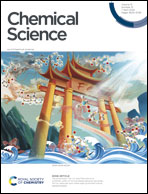Realizing highly efficient deep-blue organic light-emitting diodes towards Rec.2020 chromaticity by restricting the vibration of the molecular framework†
Abstract
Deep-blue organic light-emitting diodes (OLEDs) with narrow emission spectra and high efficiency, meeting the Rec.2020 standard, hold significant promise in the realm of 4K/8K ultrahigh-definition displays. However, the development of light-emitting materials exhibiting both narrowband emission and high efficiency, particularly in the realm of deep-blue thermally activated delayed fluorescence (TADF), confronts substantial challenges. Herein, a novel deep-blue TADF emitter, named BOC-PSi, was designed by integrating a rigid B-heterotriangulene acceptor (A) with a rigid phenazasiline donor (D). The replacement of a sp3 carbon atom with a sp3 silicon atom in the D moiety helps to restrict the low-frequency bending vibration throughout the entire D–A molecular backbone, while concurrently accelerating the multi-channel reverse intersystem crossing (RISC) processes. Notably, OLEDs using the BOC-PSi emitter exhibit exceptional performance, with a high maximum external quantum efficiency (EQEmax) approaching 20%, and a superior color purity closely aligning with the Rec.2020 blue standard.

- This article is part of the themed collection: 2024 Chemical Science HOT Article Collection


 Please wait while we load your content...
Please wait while we load your content...